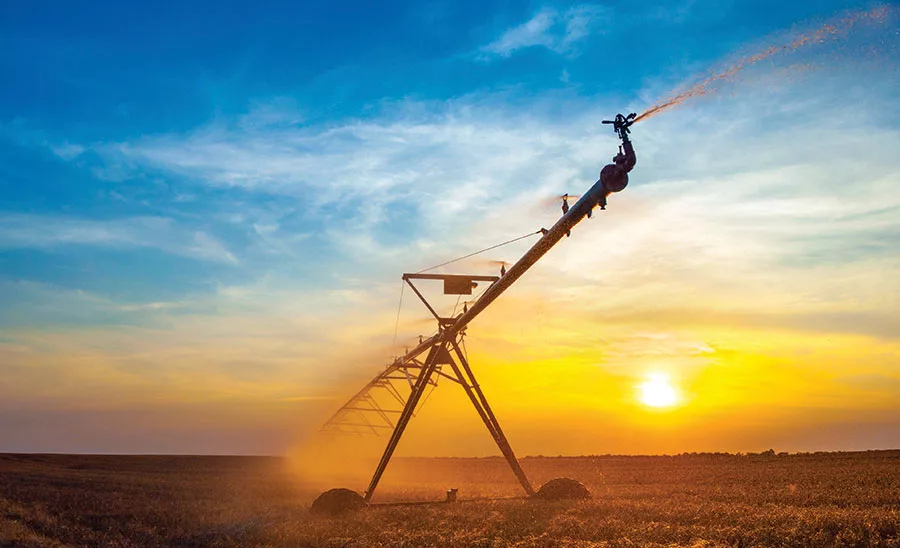Thoughts on the Irrigation Well Market

Most drillers, large and small, drill irrigation wells, and like many other fields of drilling, the market can be cyclical. The larger drillers drill irrigation wells for farmers and ranchers for crop irrigation, or livestock watering. The smaller drillers drill irrigation wells for landscape irrigation and ornamental uses. Irrigation is one of the largest uses of groundwater worldwide, and deserves some special attention.
All the fresh water stored underground in our aquifers was once rain water. The aquifer is like a savings account. You can’t take out more than goes in without eventually running out. The Ogallala Aquifer in the American Midwest and high plains is a perfect example. Recharge is mostly from snow-melt on the east side of the Rockies, and water levels have been declining there since we discovered that we could make dry land bloom and create the breadbasket of the world.
Drought causes farmers to need more water, and makes plenty of business for drillers. The current drought in California is keeping the drillers pretty busy. I have heard of two-year waiting lists. This puts additional strain on the aquifer, but is not usually recognized right away. Recharge is slow, sometimes many years. The problem is that once a farmer gets a good, reliable well, he will use it in even a non-drought year. Nothing like having it rain whenever you command! This unnecessarily depletes the aquifer in years that it should be recharging.
The other side of the irrigation well market is landscape and ornamental watering. The cycles of this market depend a lot on the housing market. If there are few housing starts, there will be less drilling. On the other side, when house values are rising and people figure that their house is worth much more than they gave for it, they tend to add on things like garages, spare rooms and irrigation wells. This doesn’t use a tremendous amount of water on the grand scale of things, but the waste is phenomenal. I’ve seen people with lots the size of your living room demand enough water to grow rice or crayfish, and they won’t settle for anything less. It’s like they want to turn on the system for 10 minutes and launch the boat out of the garage! They don’t use a lot of water total, but much of it runs down the drain because the yard can’t absorb it fast enough. These are usually million-dollar houses, so conspicuous consumption might have something to do with it. Also, in many areas, the aquifer is smaller, faulted or lensatic, and depletion is inevitable. On the coast, saltwater intrusion is also a problem. The east coast of Florida comes to mind.
My point is, we have enough water to sustain our way of life for a very long time if we use it properly. I’m not talking about getting one of those useless Al Gore toilets that will barely flush, or a showerhead that produces about as much as a bad leak, just to make everybody feel better. I’m talking about putting a rain sensor on the irrigation system that turns it off when nature provides the water. There are few things that bother me more than heading to the rig in a pounding rain, looking forward to a wet day, and seeing people’s irrigation systems adding to the flooding, just because they can. This is worth a ticket in places where the government manages all aspects of daily life. Apparently, you can’t legislate common sense.
To a certain extent, this applies to farmers too. Just because you planted yesterday, you don’t have to irrigate today if the weather report says it’ll rain tomorrow. Farmers are generally more aware than most people because they know the power bills involved. Another problem is distribution. Many people live in areas that just don’t have enough water. Southern California is a desert, and without imported water, would probably only support about 10 percent of the present population.
There is another type of “irrigation” well that is often drilled in a lot of areas. I put the word irrigation in quotes because these wells are often in a gray area of the law. There are a lot of large municipalities that provide water for everyone, and force people to hook up and pay for their water. Such as Flint, Mich. The victims, er, I mean citizens, are forbidden from having a potable water well of their own, but they can have an irrigation well. A surprising number of these wells end up hooked to the house, the residents being responsible for their own well-being, and not drinking water molested by government bureaucrats, at high prices.
Our management of our water resources is up to us in the industry. The general public is pretty sure water comes out of the faucet, and not too sure after that. We need to talk to and educate our customers on proper use of our resources. Our future depends on it.
For more Wayne Nash columns, visit www.thedriller.com/wayne.
Looking for a reprint of this article?
From high-res PDFs to custom plaques, order your copy today!

